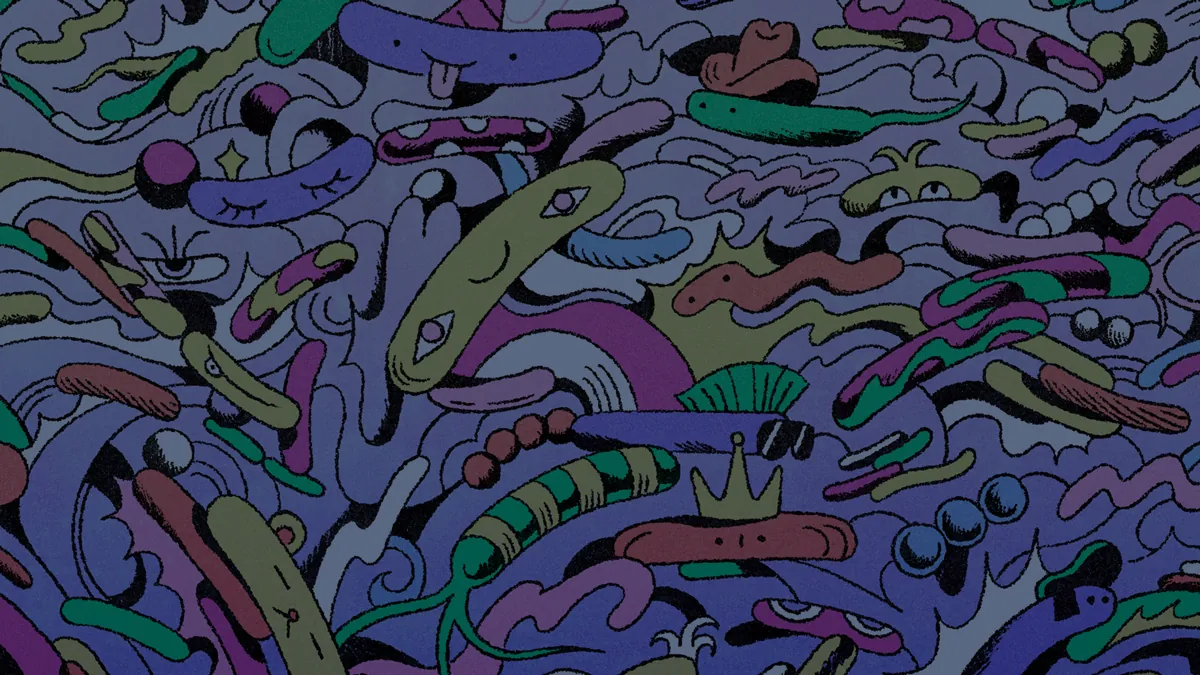Understanding Gut Microbiome Interactions to Improve Probiotics
The gut microbiome – the hundreds of bacterial species living in the digestive tract – is a complex system with a not fully understood impact on health. Anna Kuchina, the recipient of a promising investigators NIH grant (MIRA), is working to improve the design of probiotics and other microbiome therapies by understanding how gut bacteria interact and cooperate.

Illustration of the individuality of microbes in a given bacterial community. Image credit: Niv Bavarsky for ISB.
Many studies of bacteria focus on just one species, but in nature, bacteria often live in mixed, cooperative communities of dozens to hundreds of different species. The human gut microbiome is thought to be composed of hundreds to a thousand different kinds of healthy bacteria. Historically, studying the behaviors and characteristics of such a complex mixture of species has proven challenging. At ISB, Anna Kuchina, PhD, has developed new methods to characterize complex communities of bacteria at the level of individual bacterial cells. She’s using this novel technique, which is known as microSPLiT (microbial Split-Pool Ligation Transcriptomics), to study how different species of human gut bacteria change their behavior when grown in a mixed-species environment.
- Funded by National Institute of General Medical Sciences
- Led by Anna Kuchina, PhD
- Key collaborators:
- Sean Gibbons, PhD; Nitin Baliga, MsC, PhD and Christopher Lausted, all of ISB
- Ophelia Venturelli, PhD, University of Wisconsin-Madison
- Neelendu Dey, MD, Fred Hutchinson Cancer Center
A study of the rich complexity of our gut microbiomes
The microSPLiT technique allows scientists to study gene expression in single cells, giving a snapshot of how all genes are switched on or off in individual bacteria across hundreds to thousands of cells in one experiment. Kuchina has used the method to probe the diversity of single-species communities of bacteria to understand the different states bacterial cells take on even in a relatively simple laboratory environment. In related work with Neelendu Dey, MD, of Fred Hutchinson Cancer Center, Kuchina analyzed the human gut bacteria Bacteroides fragilis using microSPLiT to understand how this species changes its gene expression when infected with a bacteria-specific virus, known as a bacteriophage. They were able to see differences in gene expression characteristics in infected vs. non-infected cells, as well as to distinguish several other different subpopulations in the bacterial community.
Kuchina and her team are now working to expand this project to study the interactions between different human gut bacterial species. Because these bacteria have evolved in complex communities with other species, they often rely on each other to provide nutrients or other benefits. Previous research by Kuchina and other research teams has shown that even when grown in a test tube in the lab as a single species, cooperative bacterial species often divide into different subpopulations, some of which have switched on genes that rely on their evolutionary partner species. Kuchina hypothesizes that this baseline diversity of gene expression in a bacterial community allows them to quickly respond to helpful partner species when they become present.
The ISB team is working to study cooperative bacteria in pairs using microSPLiT to understand how bacterial subpopulations change over time when two species are grown together versus each species grown alone. They’ll carry out these studies using pairs of different human gut bacterial species. They’ll then work with ISB’s Nitin Baliga, MsC, PhD, to build computational models that explain the complexities of the resulting large gene expression dataset.
Kuchina and her team are also working to modify microSPLiT so it can be used to analyze mixtures of several different bacterial species. They’re starting with a mixture of gut bacterial species grown in the lab and, once the method works in this setting, will proceed to optimize the technique to study human gut microbiome samples from healthy donors, in collaboration with ISB’s Sean Gibbons, PhD.
Citations
- Gaisser KD, Skloss SN, Brettner LM, Paleologu L, Roco CM, Rosenberg AB, Hirano M, DePaolo RW, Seelig G, Kuchina A. High-throughput single-cell transcriptomics of bacteria using combinatorial barcoding. Nat Protoc. 2024. doi: 10.1038/s41596-024-01007-w.
- Kuchina A, Brettner LM, Paleologu L, Roco CM, Rosenberg AB, Carignano A, Kibler R, Hirano M, DePaolo RW, Seelig G. Microbial single-cell RNA sequencing by split-pool barcoding. Science. 2021. doi: 10.1126/science.aba5257.
Technologies Developed
microSPLiT (microbial Split-Pool Ligation Transcriptomics)

Contact Dr. Anna Kuchina
Assistant Professor
ISB